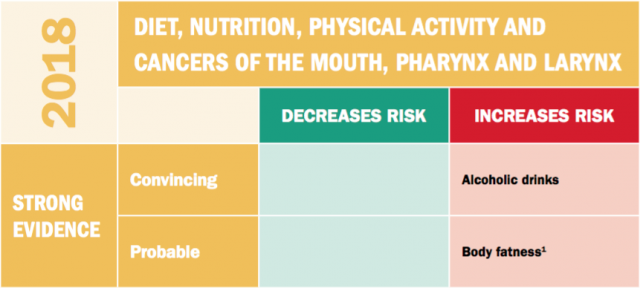Cancers of the mouth, pharynx and larynx are approximately three times more common in men than in women, which may in part be related to higher rates of smoking in men. Risk increases with age.
Oral cancers include cancers of the mouth, larynx (voice box), nasal cavity and pharynx (throat). The pharynx is the muscular cavity leading from the nose and mouth to the larynx, a muscular structure at the upper area of the windpipe, which includes the vocal cords.
AICR’S latest report on oral cancers found that maintaining a healthy weight can lower your risk. Drinking alcohol and using tobacco can increase your risk.
Lifestyle and mouth, pharynx, larynx cancers risk.
- Alcohol
There is strong evidence that drinking alcohol is a cause of cancers of the mouth, pharynx and larynx.
- The body converts alcohol into acetaldehyde, a potent carcinogen. Alcohol may act as a solvent, making it easier for carcinogens to penetrate the cells lining the colon. Alcohol can adversely affect how efficiently the body repairs DNA damage and defends against free radicals.
- Weight
Excess body fatness puts you at greater risk for oral cancers.
- Further research is needed on the mechanisms. But obesity has been shown to stimulate the inflammatory response, which may promote cancer development.
- Obesity influences hormones and endocrine functions that may contribute to the growth of cancer cells.
- Smoking
Smoking (or use of smokeless tobacco) is a cause of cancers of the mouth, pharynx and larynx.
- The vast majority of mouth cancers worldwide are attributable to tobacco use, alcohol consumption or a combination of both.

Foods that fight mouth, pharynx, larynx cancers.
No single food can protect you against cancer by itself. But research shows that a diet filled with a variety of vegetables, fruits, whole grains, beans and other plant foods helps lower risk for many cancers.
Cancer Updates
The science of survival.
AICR’s health guides and recommendations are developed from research that focuses on how nutrition and lifestyle affect the prevention, treatment, and survival of cancer. Paramount to our updates is the Continuous Update Project which helps you stay on top of new findings, and understand the data that sits at the center of our work.






